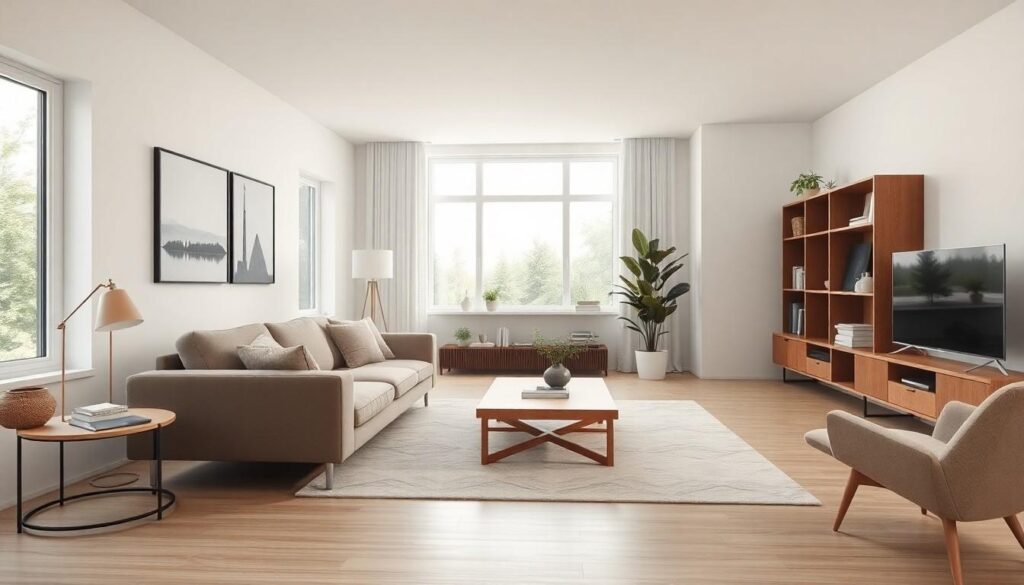Dreaming of a home makeover but worried about the price tag? You’re not alone.
With smart strategies, you can reduce renovation expenses by 10-30%.
The good news?
Home renovations can transform your living spaces and boost property value, but costs can quickly spiral out of control without proper planning.
Whether you’re eyeing a kitchen facelift or a complete room transformation, affordable options exist.
Even simple updates like new cabinet hardware can save up to 80% compared to installing entirely new cabinets.
Consider mixing DIY projects with professional work; tackling demolition yourself can save significantly on labor costs, while painting walls costs about $200 in supplies compared to $1,000+ for professional service.
Renovate Your Home Without Breaking the Bank
Home renovations don’t have to drain your bank account. With strategic approaches and smart choices, you can transform your living spaces while keeping costs manageable.
Plan Like a Pro: Starting Your Renovation Journey Right
Smart planning is your secret weapon for affordable renovations.
Before swinging that first hammer, take time to map out your renovation journey; it will save you headaches and dollars down the road.
Homeowners typically slash renovation costs by 10-30% through thoughtful preparation, strategic DIY work, and clever material choices.
Getting Your Goals and Budget in Check
Define exactly what you want to accomplish before spending a dime.
Set a realistic spending limit that includes a 15-20% buffer for unexpected issues that always seem to pop up during renovations.
Focus on high-impact spaces like your kitchen, bathroom, or living room first.
Grab a notebook and jot down your renovation wishes, then rank them by importance.
Renovation or Start Fresh? Making the Smart Call
Sometimes building new actually costs less than extensive renovations. Volume builders often deliver lower per-square-meter costs than major renovation projects.
New construction also brings improved energy efficiency and updated building standards that might save you money long-term.
Before committing to a big remodel, consider if you’re facing potential expensive surprises like cracked foundations, outdated wiring, or termite damage.
Breaking It Down: The Magic of Phased Implementation
Turn one overwhelming project into several manageable ones by breaking your renovation into phases. This approach eases financial pressure and gives you breathing room between projects.
Phasing transforms a daunting renovation into a series of satisfying wins.
Start with the spaces that’ll make the biggest difference in your daily life, like the kitchen or bathroom. You’ll enjoy completed improvements while saving for the next phase, and you can adjust plans as your needs or finances change.
Design Tricks That Won’t Empty Your Wallet

Smart design choices let you create stunning spaces without draining your bank account. These practical approaches deliver high-impact results while keeping costs manageable.
Less is More: How Minimalism Saves You Money
Minimalism isn’t just trendy – it’s a budget-saver. By focusing on clean lines, uncluttered spaces, and functional pieces, you’ll automatically cut down on materials and labor costs.
A Clementi property nailed this approach, achieving a contemporary, sophisticated look for just $20,000.
The beauty of minimalist design lies in its emphasis on quality over quantity.
Each piece serves a purpose, eliminating unnecessary expenses on decorative items that don’t add function. You’re essentially paying for what you actually need and use, creating a calming space that feels intentional rather than overcrowded.
Making Every Square Foot Count
Smart space planning saves thousands more than expanding your home’s footprint.
Replace space-hogging shelves with cabinet-height pullout drawers that utilize the full depth of spaces.
Before knocking down walls, look for ways to maximize what you already have.
Transform existing cabinets with pull-out organizers, add a lazy Susan to awkward corner spaces, or install vertical dividers to store baking sheets and cutting boards. These small tweaks create dramatic functionality improvements without the major expense of complete reconstruction.
The key is identifying underutilized spaces and making them work harder for your daily needs.
Style Steals: Industrial and Scandinavian Looks on a Budget
Industrial and Scandinavian styles deliver high-end aesthetics at surprisingly affordable prices. A 4-room HDB flat in Woodlands achieved a striking industrial look for just $23,000 by strategically combining wood and metal elements with distinctive lighting fixtures.
These design approaches celebrate raw materials and exposed elements that might actually be costly to conceal – turning budget constraints into design features.
Both styles emphasize clean lines and functional pieces, letting you achieve a designer look without the designer price tag.
Scandinavian style focuses on simplicity, natural materials, and light color palettes that create bright, airy spaces.
Material Matters: Getting the Most Bang for Your Buck

Selecting the right materials for your renovation makes all the difference in both immediate costs and long-term value. Smart choices about what you buy, and where you buy it, can transform your renovation budget from stretched to comfortable.
The Quality vs. Cost Balancing Act
That bargain-bin tile might look tempting now, but it’ll likely crack within a year. Focus on investing in quality for high-use items like flooring, countertops, and fixtures.
Remember that “good enough” materials in the wrong applications end up being the most expensive choice you can make when you’re replacing them just months later.
For less visible or less-used areas, mid-range options often provide the perfect balance.
You’ll save money by avoiding premature replacements and constant repairs.
Treasure Hunting: Where to Find Affordable Materials
Habitat for Humanity ReStores are gold mines for renovation materials at half the retail price.
Local building material exchanges also offer surprising finds at fraction-of-retail prices.
Don’t forget to ask contractors about leftover materials from their other jobs – they’re often happy to sell these at reduced rates rather than storing them. Estate sales can yield vintage fixtures and hardware that add character while saving money.
Check salvage yards, architectural salvage shops, and online marketplaces like Facebook Marketplace or Craigslist for incredible deals.
Giving Old Materials New Life
Those worn kitchen cabinets? Paint them instead of replacing them and save thousands.
Upcycling isn’t just budget-friendly – it’s environmentally responsible and often creates the most interesting focal points in your renovation. Creative repurposing turns ordinary items into conversation pieces that make your space uniquely yours.
Even old bathroom vanities take on new life with fresh hardware and countertops.
Refinishing your existing hardwood floors preserves their unique character while cutting costs dramatically compared to new installations. Furniture pieces can transform with reupholstering or paint treatments.
Working with Contractors Without the Headaches

Finding the right contractor can make or break your renovation experience. Working with professionals doesn’t have to be stressful if you know how to approach the relationship strategically and communicate effectively.
Why the Cheapest Bid Might Cost You More
That rock-bottom estimate might look tempting, but cheaper isn’t better when it comes to home renovations. Low bids often lead to expensive headaches down the road, such as shoddy workmanship, delayed timelines, and cut corners on materials.
A slightly higher upfront cost typically translates to quality work done right the first time, saving you from paying twice for the same job.
Look at their experience, expertise, reputation, and references alongside their estimate. Check online reviews and talk to previous clients to verify their track record.
Instead of focusing solely on price, evaluate contractors holistically.
Getting Contractors Involved Early Saves Money Later
Bring your contractor into the conversation before finalizing your designs. Early involvement lets professionals spot potential construction issues before work begins, preventing expensive mid-project changes.
It creates a streamlined communication channel and delivers cost savings through efficiency. Making all important decisions before hammering starts prevents costly delays later.
This integrated approach ensures your budget informs design decisions from the start, avoiding the heartbreak of developing plans you can’t afford. The design-build process, where design and construction fall under one team, offers significant advantages for budget management.
Smart Timing and Negotiation Tactics
Schedule your renovation during contractors’ off-peak seasons to score significant savings. Many pros offer discounted rates during winter months or between major holidays when work typically slows down.
Communicate clearly about your expectations, and collaborate to identify cost-saving opportunities. Remember that last-minute changes and indecision lead to expensive adjustments, so finalize your plans before work begins.
Be upfront about your budget constraints, as most contractors appreciate honesty and can suggest creative ways to achieve your goals without compromising quality or safety.
They’d rather keep their crews busy at reduced rates than have no work at all.
DIY vs. Pro: Finding Your Sweet Spot
Balancing DIY efforts with professional help lets you maximize your renovation budget while ensuring quality results. The trick is knowing when to grab your tools and when to call in the experts.
Know Your Limits: When to DIY and When to Call In Help
You can tackle lots of home projects yourself – painting walls, swapping out hardware, or sprucing up your landscaping don’t require special training.
These projects involve safety codes and technical knowledge that most homeowners don’t have. An honest assessment of your skills saves money and headaches – DIY mistakes often lead to costly professional fixes that wipe out any initial savings.
But pumping the brakes before diving into complex systems like electrical work, plumbing, or structural changes is smart.
These simple upgrades immediately transform your space without breaking the bank.
DIY Projects That Give You the Most Value
Painting delivers the biggest bang for your DIY buck – transforming a room for about $200 in supplies compared to $1,000+ for hiring pros. Other high-value DIY projects include installing new light fixtures, updating cabinet hardware, or laying peel-and-stick backsplash tiles.
The key is picking projects where your time investment translates to substantial savings.
These upgrades create dramatic visual impact without requiring specialized skills. Even modest landscaping projects like mulching beds or planting perennials boost curb appeal dramatically while keeping labor costs in your pocket.
The Best of Both Worlds: Teaming Up With Pros
The smartest approach often combines DIY work with professional expertise. You might handle demolition and prep work yourself, then bring in experts for the specialized middle phases before taking back over for finishing touches.
Communicating your DIY intentions upfront helps contractors adjust their quotes and timelines accordingly, creating a collaboration that respects both your budget and the project’s quality requirements.
This partnership approach cuts labor costs while ensuring critical components are professionally installed. For example, you could remove old flooring and baseboards yourself, have pros install new hardwood, then handle the staining and sealing on your own.
Room-by-Room Renovation Strategies
Different rooms present unique renovation challenges and opportunities for budget-conscious homeowners. Understanding the specific needs of each space allows you to target your efforts and control costs more effectively.
Kitchen Makeovers That Won’t Cook Your Budget
Your kitchen renovation doesn’t have to devour your savings.
Adding pull-out organizers to existing cabinets or a lazy Susan to corner spaces dramatically improves functionality without structural changes.
Repairing or updating cabinet hardware saves up to 80% compared to buying new cabinets – try painting existing cabinetry, refinishing surfaces, or just swapping out handles and knobs. Look for affordable statement countertops with visual impact, and upgrade your sink for significant functional improvement starting at around $150.
Keep existing plumbing layouts to avoid expensive modifications and focus on high-impact changes instead.
Bathroom Updates That Make a Splash Without Draining Your Wallet
Like kitchens, bathrooms benefit enormously from maintaining existing plumbing configurations.
Peel-and-stick backsplash tiles offer an inexpensive yet impactful upgrade you can install yourself without professional help.
For a luxury feel without premium pricing, pair quality fixtures with standard white bathroom suites.
Even moving a toilet or shower a short distance significantly increases costs due to plumbing modifications, so focus on updating fixtures and finishes while keeping major elements in place. Replace outdated faucets, showerheads, and towel racks with stylish but economical alternatives.
Living Spaces: Big Impact, Small Price Tag
Transform your living areas with strategic changes that don’t require major construction.
Low-cost accessories like throw pillows and area rugs can completely refresh a space’s appearance.
Consider adopting minimalist or Scandinavian design principles that emphasize clean lines and simple materials, giving you a high-end look without the designer price tag.
Create visual interest with DIY artwork or by rearranging existing pieces to improve flow and functionality.
Painting walls is one of the most affordable transformations – costing around $200 in supplies compared to $1,000+ for professional service.
Strategic furniture arrangement and thoughtful lighting dramatically improve living spaces without significant expense.
Think Long-Term: Investments That Pay Off
Transforming your home doesn’t need to empty your bank account. With strategic planning and thoughtful choices you can create beautiful spaces that reflect your style while staying within budget.
Remember that some renovations pay for themselves over time through increased property value or energy savings. Focus on projects that bring you joy daily and meet your functional needs.
By breaking projects into phases tackling some tasks yourself and shopping smart for materials you’ll stretch your renovation dollars further than you might expect.
Your dream home is within reach. Take that first step today with a small project and watch how your confidence grows along with your home’s beauty and value.

